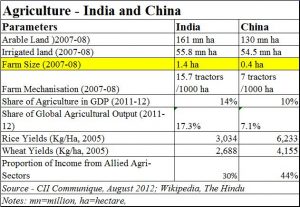http://www.dnaindia.com/money/report-policy-watch-indian-agriculture-pampered-and-terribly-exploited-1828230
With smaller holdings China does better
Monday, 29 April 2013 – 8:30am IST | Agency: dna
China doesn’t subsidise, but has done a lot better by investing in agri infrastructure.
Politicians love to swear by the poor farmer. That explains why the Congress (I) – the ruling party at the Centre – has opted to squander away money through loan melas, loan write-offs and even agricultural doles through its pet scheme, Mahatma Gandhi National Rural
Employment Guarantee Act (MNREGA).
One would have thought that with such schemes and largesse, the Indian farmer should be
doing extremely well. The politically connected rich agriculturists may be well-off, either by
merit or by diversion of funds. But the small agriculturist has been left holding the can. Literally.
 A simple comparison between India and China in respect of agricultural performance highlights this quite sharply. At first blush, it looks as if India has the upper hand. It has more arable land, much more water and bigger average agricultural land holdings than what China has.
A simple comparison between India and China in respect of agricultural performance highlights this quite sharply. At first blush, it looks as if India has the upper hand. It has more arable land, much more water and bigger average agricultural land holdings than what China has.
But as one scrolls down the table, one realises China is way ahead compared with the Indian farmer. While India may still boast of a higher agricultural output and a higher percentage of global agricultural output, the fact is China’s agricultural yields are higher.
And, most importantly, it has a higher proportion of income from allied agri-sectors. While the share of agriculture in China’s GDP is just 10% – hence lower than the 14% share of GDP enjoyed by India’s agriculture – it masks the value.
In 2011-12, China’s GDP stood at $8,226,885 million ($8.2 trillion). India’s was barely $1.8
trillion. Thus, China’s agricultural output gets valued at $822 million while India’s at just
$252 million.
Why? After all, doesn’t India have more farm mechanisation than China, and bigger average land holdings? One reason could be China’s reluctance to provide subsidies to its farmers for electricity or fertilisers because the government there believes that on the whole, subsidies are against market reforms. They distort the market and reduce resource efficiency (Dr S. Vijaykumar, independent analyst, http://vijaysvision.blogspot.in/2012/06/comparativestudy-of-agriculture-in.html).
Instead, China focuses on investment in agriculture and infrastructure. It knows that agricultural produce must reach the market through roads, trains, cold chain systems and food processing industries.
As economists never tire of pointing out, China’s agriculture thus enjoys a 30 times greater value addition than India’s produce. By using its money in such investments, rather than on subsidies, it has made its agriculture – and hence its farmers – a lot more vibrant than India has.
Are India’s policymakers listening?


































COMMENTS